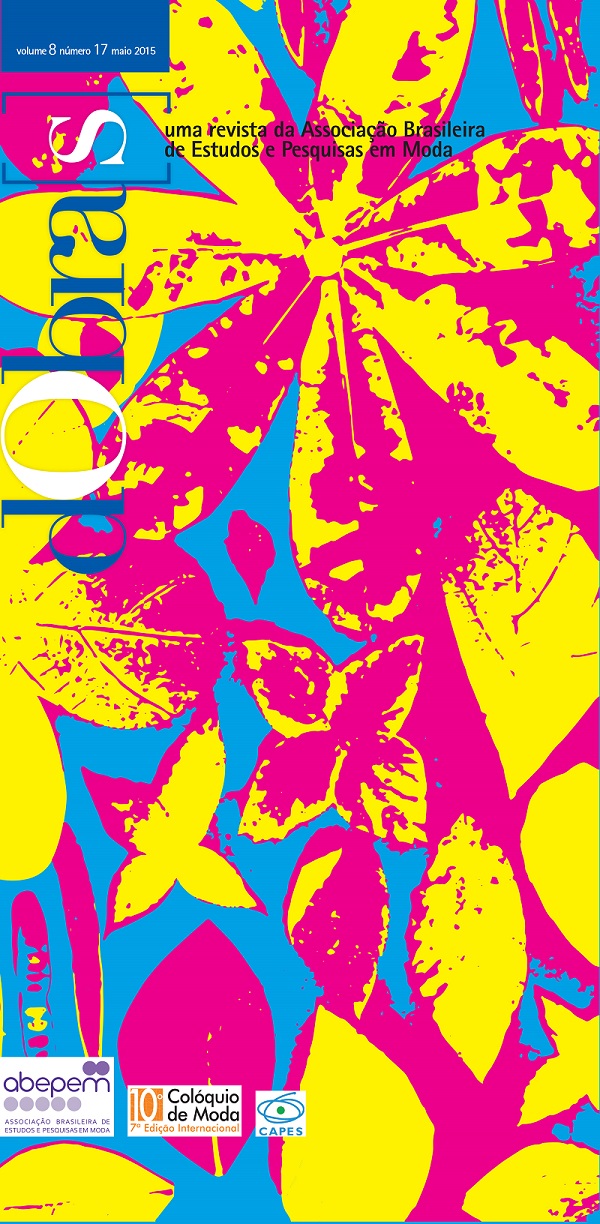Dialogues between fashion brands and the film narrative in Anna Karenina
DOI:
https://doi.org/10.26563/dobras.v8i17.6Keywords:
fashion, consumption, cinema, narrative.Abstract
In this study, we used the film Anna Karenina, winner of the Oscar for best costume design in 2013, to analyze the scene clothing not only as an element of the film narrative, but also as an element that allows adding the values of acclaimed brands of consumer goods to the narrative. The aim of this work is to contribute to understand a sort of social dynamics of consumption in present days.Downloads
References
BENJAMIN, Walter. Obras escolhidas: magia e técnica, arte e política. São Paulo: Brasiliense, 1994.
BARNARD, Malcon. Moda e comunicação. Rio de Janeiro: Rocco, 2003.
COSTA, Francisco Araujo da. O figurino como elemento essencial da narrativa. Famecos: sessões do imaginário. Porto Alegre, n. 8, p. 38-41, ago. 2002.
DICHTER, Ernest. Why we dress the way we do. In: SOLOMON, MIchael R. (Ed.). The psychology of fashion. Massachusetts: Lexington Books, 1985, p. 29-38.
DONDIS, Donis A. Sintaxe da linguagem visual. São Paulo: Martins Fontes, 1997.
DURRAN, Jacqueline. Meet the woman behind Keira Knightley’s Anna Karenina costumes: Jacqueline Durran. The Fashion Spot. 14 nov. 2012. Entrevista a Jennifer Davidson. Disponível em: <http://www.thefashionspot.com/runway-news/177335-meet-the-woman-behind-keira-knightlys-anna-karenina-costumes-jacqueline-durran/>. Acesso em: 16 dez. 2013.
______. An interview with Oscar-winning costume designer Jacqueline Durran. Huffington Post. 26 fev. 2013. Entrevista a Mary Hall. Disponível em: <http://www.huffingtonpost.com/mary-hall/jacqueline-durran-best-costume-design-oscars_b_2762016.html>. Acesso em: 16 dez. 2013.
ECO, Umberto. Apocalípticos e integrados. São Paulo: Perspectiva, 2004.
JULLIER, Laurent; MARIE, Michel. Lendo as imagens do cinema. São Paulo: Senac, 2012.
KOURLAS, Gia. Making words dance on screen. The New York Times. Nova York, p. C1, 24 nov. 2012.
LÉVI-STRAUSS, C. O pensamento selvagem. São Paulo: USP,1970.
LIPOVETSKY, Gilles. O império do efêmero: a moda e o seu destino nas sociedades modernas. São Paulo: Companhia das Letras, 1989.
LURIE, Alison. A linguagem das roupas. Rio de Janeiro: Rocco, 1997.
MACIEL, E. J. C. ; MIRANDA, Ana Paula Celso de. DNA da imagem de moda. In: V COLÓQUIO NACIONAL DE MODA, 2009, Recife. Anais do V Colóquio Nacional de Moda, 2009.
PENN, Gemma. Análise semiótica de imagens paradas. In: BAUER, Martin; GASKELL, George. Pesquisa qualitativa com texto, imagem e som: um manual prático. Petrópolis: Vozes, 2002, p. 319-342.
SOLOMON, Michael R. Consumer behavior: buying, having, and being. Massachusetts: Prentice-Hall, Inc. New-Jersey. 1996.
SPROLES, George B. Behavioral science theories of fashion. In: SOLOMON, MIchael R. (Ed.). The psychology of fashion. Massachusetts: Lexington Books, 1985, p. 55-70.
THOMPSON, C. J.; Caring consumers: gendered consumption meanings and the juggling lifestyle. Journal of Consumer Research. Vol. 22 March, 1996. DOI: https://doi.org/10.1086/209457
WRIGHT, Joe. Anna Karenina. [Filme]. Produção anglo-americana dirigida por Joe Wright. 129 min. color. son.
Downloads
Published
How to Cite
Issue
Section
License
The copyrights of the works published in this journal belong to the author, and dObra[s] holds the rights of first publication. Due to their publication in this open access journal, any work here is free to use, with its own attributions, in educational and non-commercial applications.










